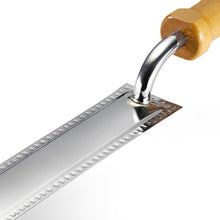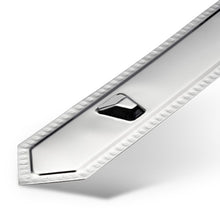
This Speed King Uncapping Knife is the ideal tool for processing honeycomb. Use this knife to remove the beeswax cap (uncapping) on honeycomb honey cells. It is easy to use, requires minimal pre-heating and has a fully built-in temperature control. Please read the instructions enclosed on the correct use of this tool. Failure to follow the instructions could cause injury, damage this tool and void your warranty. Save and review these instructions each time you use this product! 120 Volt
Uncapping Notes
To remove the beeswax cap on each cell, uncap with either an upward or downward motion allowing the wax cappings to fall away from the knife blade. Remove just enough of the beeswax to allow the honey to come out, this will minimize the work the bees will need to do to repair and refill these honey cells. Use an uncapping stroke that will not strike any part of your body, Some honey processors use a slight sawing motion while cutting off the beeswax caps.
CAUTION-AVOID INJURY: If you uncap with an upward stroke, be sure to keep your other hand AND thumb that is holding the frame of honeycomb out of the path of the knife. Knife is sharp and gets hot! Work safely when uncapping and don ’t cut or burn yourself.
Cool knife as needed by plunqinq blade into a pile of uncappings. Set your hot SPEED KING only on a nonflammable, no-melt surface if you set it down.
Develop an uncapping stroke that will allow you to uncap an entire side of a frame in a single stroke using the frame itself as a guide for the knife.
Use the entire length of the blade to distribute the heat of the knife evenly across the work surface for your best uncapping results. Use pointed end of knife to get into corners and score difficult to reach areas on the comb. Fatter combs are easy to process with this tool.
Uncapping Honey is a sticky process. Plan in advance how to keep your work area clean as you work. You can use damp cloth towels to keep the work tools and uncapping area clean. Plan your uncapping work flow to make it easy on yourself. Your tools should be ready and clean; the work area clean and well lighted and all items ready within easy reach. Do not track honey about on your shoes. Keeping the mess to a minimum helps avoid unnecessary clean up and explanations!
Avoid dropping knife or hitting other objects with knife and never use the knife as a prying tool to pry frames out.
Clean knife before and after each use with a damp, but not wet cloth. Clean knife when knife is warm as a warm knife is easiest to clean. Keep knife clean for best results.
Never immerse this knife in water, this will ruin the knife and will void your warranty.
Use caution when handling the knife, it is capable of both burning and cutting your skin! '
Always unplug tool when not in use and to turn off tool. Never leave tool plugged in for extended periods or leave plugged in when you are not present.
Caution: Avoid cutting the cord with the knife. Inspectand clean the knife before and after each use and do not use if wires are frayed. Keep out of reach of children.
How to get deeper honeycomb cells?
Create deeper cells by reducing the number of frames in a 10 frame super to 9 frames, but only after the bees have drawn out the frames and you have uncapped the honey. Use these processed frames as the bees templates for deeper honeycomb cells. Deeper honeycombs means fewer frames and less work for the bee keeper or honey processor. Let the bees draw out the comb before going to 9 frames to help prevent disorganized comb building and extra burr comb.











